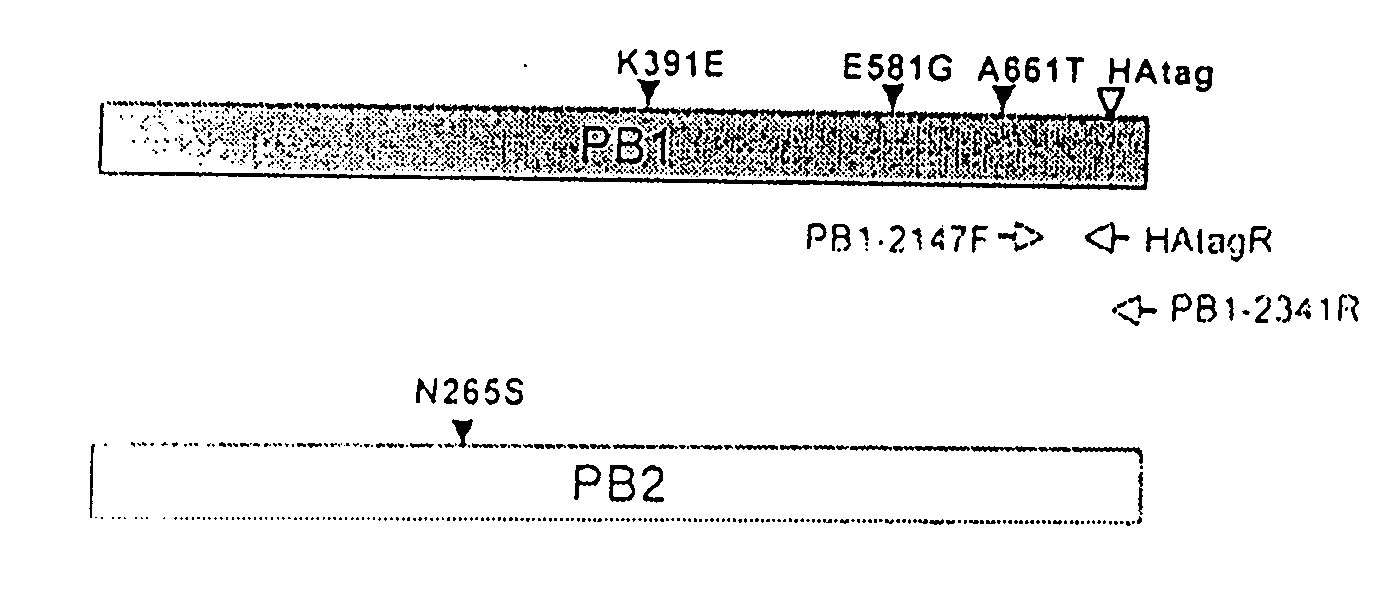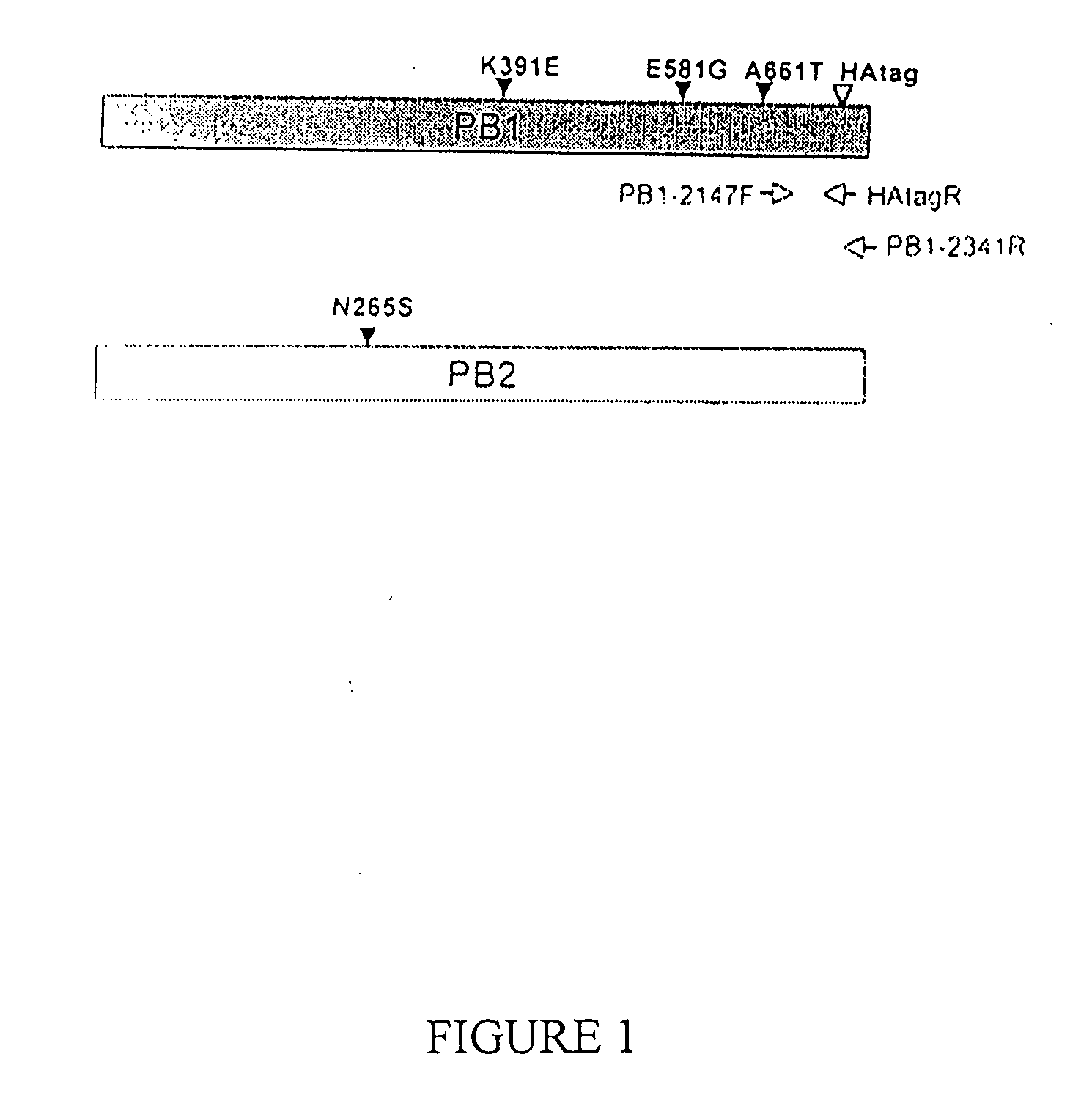Avian influenza virus live attenuated vaccine and uses thereof
- Summary
- Abstract
- Description
- Claims
- Application Information
AI Technical Summary
Benefits of technology
Problems solved by technology
Method used
Image
Examples
example 1
The ts Phenotype of the PB1 and PB2 Genes in the ca / ts / att A / Ann Arbor / 6 / 60 Can be Transferred to an Avian Influenza Virus
[0126]The ts phenotype of the A / Ann Arbor / 6 / 60 (H2N2), the master donor of the cold-adapted human influenza virus, has been mapped to three amino acid mutations in PB1 (K391E, E581G, A661T), one in PB2 (N265S), and one in NP (D34G) (Jin et al., 2003, Virology 306, 18-24). Viruses carrying these mutations can replicate efficiently in vitro at a temperature of about 33° C. but are restricted for growth at 38-39° C. The attenuation phenotype is observed in vivo in the ferret model in which the mutant viruses establish limited infection in the upper respiratory tract but not in the lower respiratory tract (Jin et al., 2004, J. Virol. 78, 995-998). Sequence alignment of the PB1 and PB2 genes revealed that avian influenza viruses do not carry the amino acid mutations found in the ca / ts A / Ann Arbor / 6 / 60 strain and thus are not expected to have a ca / ts phenotype (not sho...
example 2
An Additional Genetic Modification in the PB1 Gene of an Avian Influenza Virus Enhances the ts Phenotype In Vitro and the Att Phenotype in Birds
[0129]Using reverse genetics, we had previously generated a laboratory strain of influenza A / WSN / 33 (H1N1) carrying a recombinant PB1 gene in which the C-terminus of PB1 was fused to an 8 amino acid HA epitope tag (PB1tag) (Perez, unpublished). The growth kinetics of the 7WSN:1PB1tag virus was slower than the wild type virus, although it reached titers similar to those obtained with the wild type strain at 37° C. and displayed a is phenotype at 39° C. (not shown). We wanted to determine if avian influenza viruses carrying a PB1tag recombinant gene in the context of other ts mutations would be attenuated in birds. We modified the PB1 of the wild type WF10 virus to carry just the HA epitope tag (tag) or the HA tag with the ts loci (att) (FIG. 1). The new recovered viruses were labeled as 7tagWF10:1malH7 and 7attWF10:1malH7, respectively. The r...
example 3
A single Vaccination Dose of the 6attWF10:2ckH7N2 Virus Protects Chickens from Challenge with a Low Pathogenic avian H7 Influenza Virus
[0134]In order to evaluate protective efficacy of the modified live attenuated virus at different doses, 2 week-old chickens were vaccinated intranasally, intraocularly, orally, and intratracheally with 50, 500, 5000, 5×1014, 5×105 or 106EID50 of the 6attWF10:2ckH7N2 virus (Table 4). At 2
TABLE 2Transmission studies of the recombinant viruses in chickensaNumber with positive trachealSeroconversioncswab / total N(seroconverted / Virus / groupsDay 1Day 3Day 5Day 7Day 9total)6WF10:2ckH7N2Inoculated3 / 33 / 32 / 30 / 30 / 33 / 3chickenbContact0 / 30 / 32 / 32 / 30 / 32 / 36tsWF10:2ckH7N2Inoculated3 / 33 / 33 / 30 / 30 / 33 / 3chickenbContact0 / 30 / 30 / 30 / 30 / 30 / 36tagWF10:2ckH7N2Inoculated3 / 33 / 31 / 30 / 30 / 33 / 3chickenbContact0 / 30 / 30 / 30 / 30 / 30 / 36attWF10:2ckH7N2Inoculated3 / 33 / 32 / 30 / 30 / 33 / 3chickenbContact0 / 30 / 30 / 30 / 30 / 30 / 3aThree 3-week old White Leghorn chickens were inoculated intraocularly, intranasally, or...
PUM
| Property | Measurement | Unit |
|---|---|---|
| Temperature | aaaaa | aaaaa |
| Volume | aaaaa | aaaaa |
| Volume | aaaaa | aaaaa |
Abstract
Description
Claims
Application Information
 Login to View More
Login to View More - R&D
- Intellectual Property
- Life Sciences
- Materials
- Tech Scout
- Unparalleled Data Quality
- Higher Quality Content
- 60% Fewer Hallucinations
Browse by: Latest US Patents, China's latest patents, Technical Efficacy Thesaurus, Application Domain, Technology Topic, Popular Technical Reports.
© 2025 PatSnap. All rights reserved.Legal|Privacy policy|Modern Slavery Act Transparency Statement|Sitemap|About US| Contact US: help@patsnap.com


